Water Extraction from Fully Polarized SAR Based on Combined Polarization and Texture Features
Abstract
:1. Introduction
2. Study area and Data
2.1. Study Area
2.2. Data Preprocessing
3. Method
3.1. Coherent Target Polarization Decomposition
3.1.1. Pauli Decomposition
3.1.2. Krogager Decomposition
3.1.3. Huynen Decomposition
3.1.4. Cloude–Pottier Decomposition
3.1.5. Van Zyl Decomposition
3.1.6. Freeman–Durden Decomposition
3.1.7. Yamaguchi Decomposition
3.2. Feature Extraction of Texture
3.3. Separability Index
4. Results
4.1. Analysis of Feature Selection Results
4.2. Water Classification and Accuracy Analysis
5. Discussion and Conclusions
Author Contributions
Funding
Institutional Review Board Statement
Informed Consent Statement
Data Availability Statement
Acknowledgments
Conflicts of Interest
References
- Allen, M.R.; Ingram, W.J. Constraints on future changes in climate and the hydrologic cycle. Nature 2002, 419, 224–232. [Google Scholar] [CrossRef] [PubMed]
- Wang, Y.; Ruan, R.; She, Y. Extraction of water information based on RADARSAT SAR and Landsat ETM+. Procedia Environ. Sci. 2011, 10 Pt C, 2301–2306. [Google Scholar] [CrossRef] [Green Version]
- Chen, Y.; Fan, R.S.; Yang, X.C.; Wang, J.; Latif, A. Extraction of urban water bodies from high-resolution remote-sensing imagery using deep learning. Water 2018, 10, 585. [Google Scholar] [CrossRef] [Green Version]
- Chini, M.; Hostache, R.; Giustarini, L.; Matgen, P. A Hierarchical Split-Based Approach for Parametric Thresholding of SAR Images: Flood Inundation as a Test Case. IEEE Trans. Geosci. Remote Sens. 2017, 55, 6975–6988. [Google Scholar] [CrossRef]
- Immerzeel, W.W.; Van Beek, L.P.H.; Bierkens, M.F.P. Climate Change Will Affect the Asian Water Towers. Science 2010, 328, 1382–1385. [Google Scholar] [CrossRef] [PubMed]
- Canaz, S.; Karsli, F.; Guneroglu, A.; Dihkan, M. Automatic boundary extraction of inland water bodies using LiDAR data. Ocean. Coast. Manag. 2015, 118, 158–166. [Google Scholar] [CrossRef]
- Lee, S.U.; Chung, S.Y.; Park, R.H. A comparative performance study of several global thresholding techniques for segmentation. Comput. Vis. Graph. Image Process. 1990, 52, 171–190. [Google Scholar] [CrossRef]
- Cohen, L.D. On active contour models and balloons. CVGIP Image Underst. 1991, 53, 211–218. [Google Scholar] [CrossRef]
- Klemenjak, S.; Waske, B.; Valero, S.; Chanussot, J. Automatic detection of rivers in high resolution SAR data. IEEE J. Sel. Top. Appl. Earth Obs. Remote Sens. 2012, 5, 1364–1372. [Google Scholar] [CrossRef] [Green Version]
- Zhang, K.; Song, H.; Zhang, L. Active contours driven by local image fitting energy. Pattern Recognit. 2010, 43, 1199–1206. [Google Scholar] [CrossRef]
- Deng, Y.; Zhang, H.; Wang, C.; Liu, M. An object-oriented polarimetric SAR water body extraction method combining texture and polarimetric decomposition. Remote Sens. Technol. Appl. 2016, 31, 714–723. (In Chinese) [Google Scholar]
- Song, H.P. Study on Polarimetric SAR Typical Feature Extraction Technology; The PLA Information Engineering University: Zhengzhou, China, 2012. (In Chinese) [Google Scholar]
- Hou, A.Y.; Kakar, R.K.; Neeck, S.; Azarbarzin, A.A.; Kummerow, C.D.; Kojima, M.; Oki, R.; Nakamura, K.; Iguchi, T. The global precipitation measurement mission. Bull. Am. Meteorol. Soc. 2014, 95, 701–722. [Google Scholar] [CrossRef]
- Gaglione, D.; Clemente, C.; Pallotta, L.; Proudler, I.; De Maio, A.; Soraghan, J.J. Krogager decomposition and Pseudo-Zernike moments for polarimetric distributed ATR. In Proceedings of the 2014 Sensor Signal Processing for Defence (SSPD), Edinburgh, UK, 8–9 September 201.
- Kidd, C.; Huffman, G. Global precipitation measurement. Meteorol. Appl. 2011, 18, 334–353. [Google Scholar] [CrossRef]
- Goodrich, D.C.; Faurès, J.-M.; Woolhiser, D.A.; Lane, L.J.; Sorooshian, S. Measurement and analysis of small-scale convective storm rainfall variability. J. Hydrol. 1995, 173, 283–308. [Google Scholar] [CrossRef]
- Lin, A.; Wang, X.L. An algorithm for blending multiple satellite precipitation estimates with in situ precipitation measurements in Canada. J. Geophys. Res. Atmos. 2011, 116, D21. [Google Scholar] [CrossRef] [Green Version]
- Yilmaz, K.K.; Hogue, T.S.; Hsu, K.L.; Sorooshian, S.; Gupta, H.V.; Wagener, T. Intercomparison of Rain Gauge, Radar, and Satellite-Based Precipitation Estimates with Emphasis on Hydrologic Forecasting. J. Hydrometeorol. 2005, 6, 497–517. [Google Scholar] [CrossRef]
- Van Zyl, J.J. Application of Cloude’s target decomposition theorem to polarimetric imaging radar data. Int. Soc. Opt. Photonics 1992, 1784, 184–191. [Google Scholar]
- Van Zyl, J.J.; Kim, Y.; Arii, M. Requirements for Model-based Polarimetric Decompositions. In Proceedings of the 7th European Conference on Synthetic Aperture Radar, Friedrichshafen, Germany, 2–5 June 2008. [Google Scholar]
- Li, P.; Xu, X.; Dong, H. Polarimetric SAR image feature selection and multi-layer SVM classification using separability index. Computer application. J. Comput. Appl. 2018, 38, 132–136. [Google Scholar]
- Cloude, S.R.; Pottier, E. An entropy based classification scheme for land applications of polarimetric SAR. IEEE Trans. Geosci. Remote Sens. 1997, 35, 68–78. [Google Scholar] [CrossRef]
- Cloude, S.R.; Papathanassiou, K.; Hajnsek, I. An Eigenvector Method for the Extraction of Surface Parameters in Polarmetric SAR. SAR Workshop CEOS Comm. Earth Obs. Satell. 2000, 450, 693–698. [Google Scholar]
- Ebert, E.E.; Janowiak, J.E.; Kidd, C. Comparison of Near-Real-Time Precipitation Estimates from Satellite Observations and Numerical Models. Bull. Am. Meteorol. Soc. 2010, 88, 47–64. [Google Scholar] [CrossRef] [Green Version]
- Cloude, S.R.; Pottier, E. Concept of polarization entropy in optical scattering. Opt. Eng. 1995, 34, 1599–1610. [Google Scholar] [CrossRef]
- Freeman, A.; Durden, S.L. Three-component scattering model to describe polarimetric SAR data. Int. Soc. Opt. Photonics 1992, 1784, 213–224. [Google Scholar]
- Freeman, A.; Durden, S.L. A three-component scattering model for polarimetric SAR data. IEEE Trans. Geosci. Remote Sens. 1998, 36, 963–973. [Google Scholar] [CrossRef] [Green Version]
- Yamaguchi, Y.; Moriyama, T.; Ishido, M.; Yamada, H. Four-component scattering model for polarimetric SAR image decomposition. IEEE Trans. Geosci. Remote Sens. 2005, 43, 1699–1706. [Google Scholar] [CrossRef]
- Yamaguchi, Y.; Sato, A.; Boerner, W.M.; Sato, R.; Yamada, H. Four-component scattering power decomposition with rotation of coherency matrix. IEEE Trans. Geosci. Remote Sens. 2011, 49, 2251–2258. [Google Scholar] [CrossRef]
- Yamaguchi, Y.; Singh, G.; Park, S.-E.; Yamada, H. Scattering power decomposition using fully polarimetric information. In Proceedings of the 2012 IEEE International Geoscience and Remote Sensing Symposium, Munich, Germany, 22–27 July 2012. [Google Scholar]
- Yamaguchi, Y.; Singh, G.; Cui, Y.; Park, S.E.; Yamada, H.; Sato, R. Comparison of model-based four-component scattering power decompositions. In Proceedings of the 2013 Asia-Pacific Conference on Synthetic Aperture Radar (APSAR), Tsukuba, Japan, 23–27 September 2013. [Google Scholar]
- Haralick, R.M.; Shanmugam, K.; Dinstein, I. Textural Feasures for Image Classification. IEEE Trans. Syst. Man Cybern. 1973, 3, 610–621. [Google Scholar] [CrossRef] [Green Version]
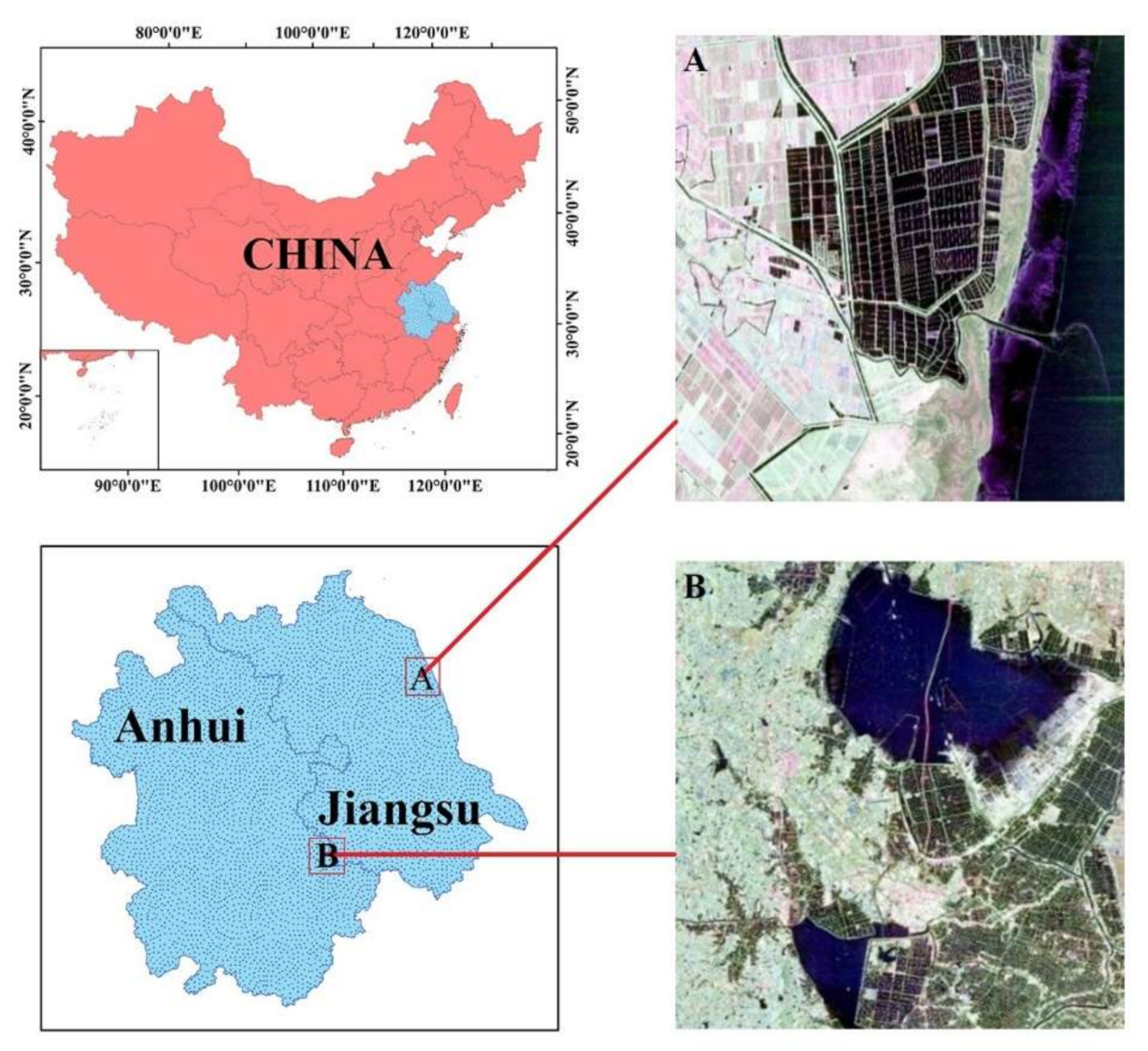
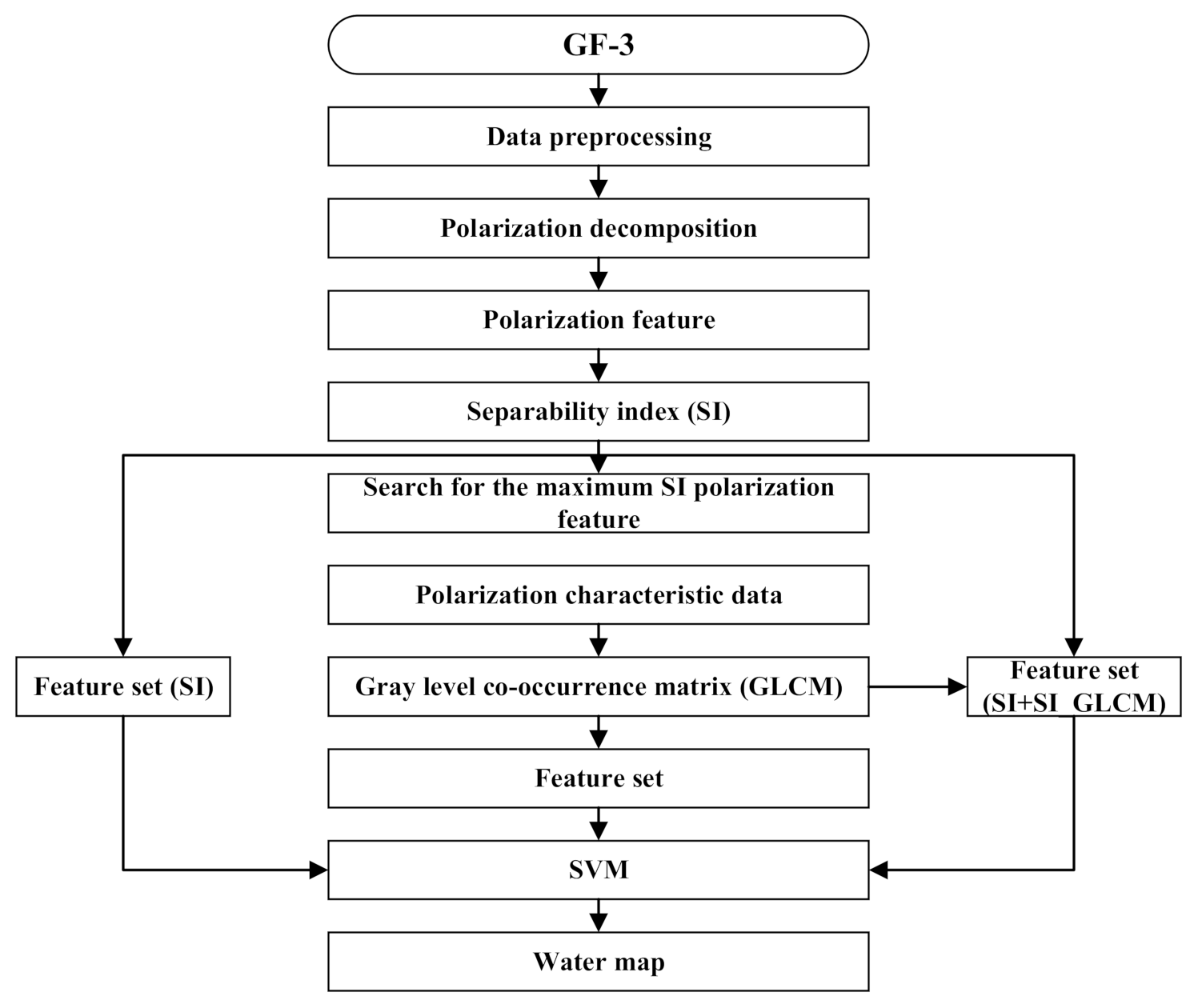
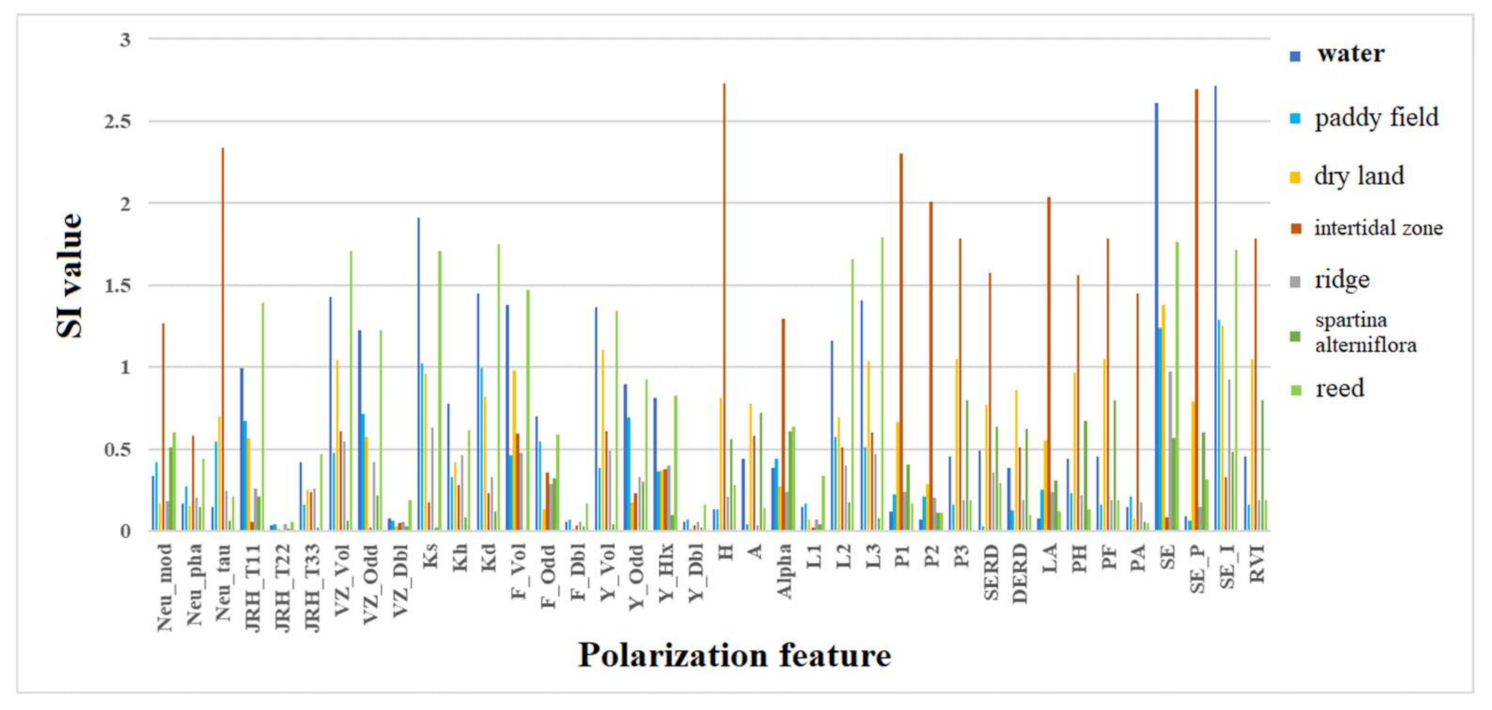
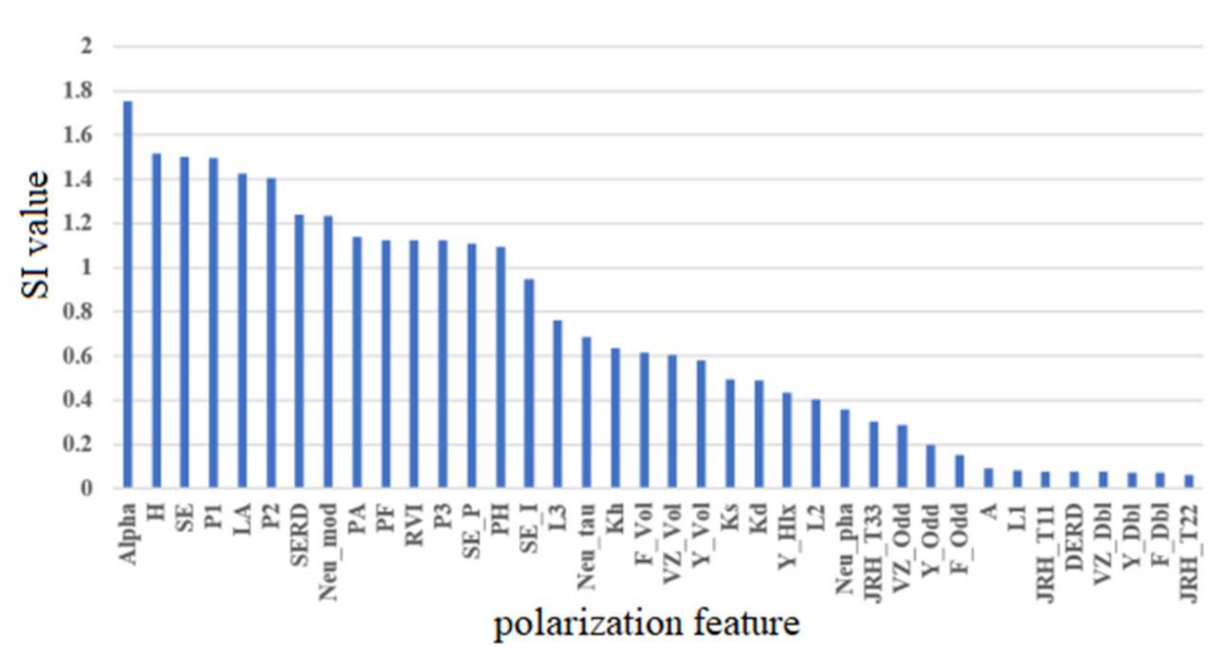
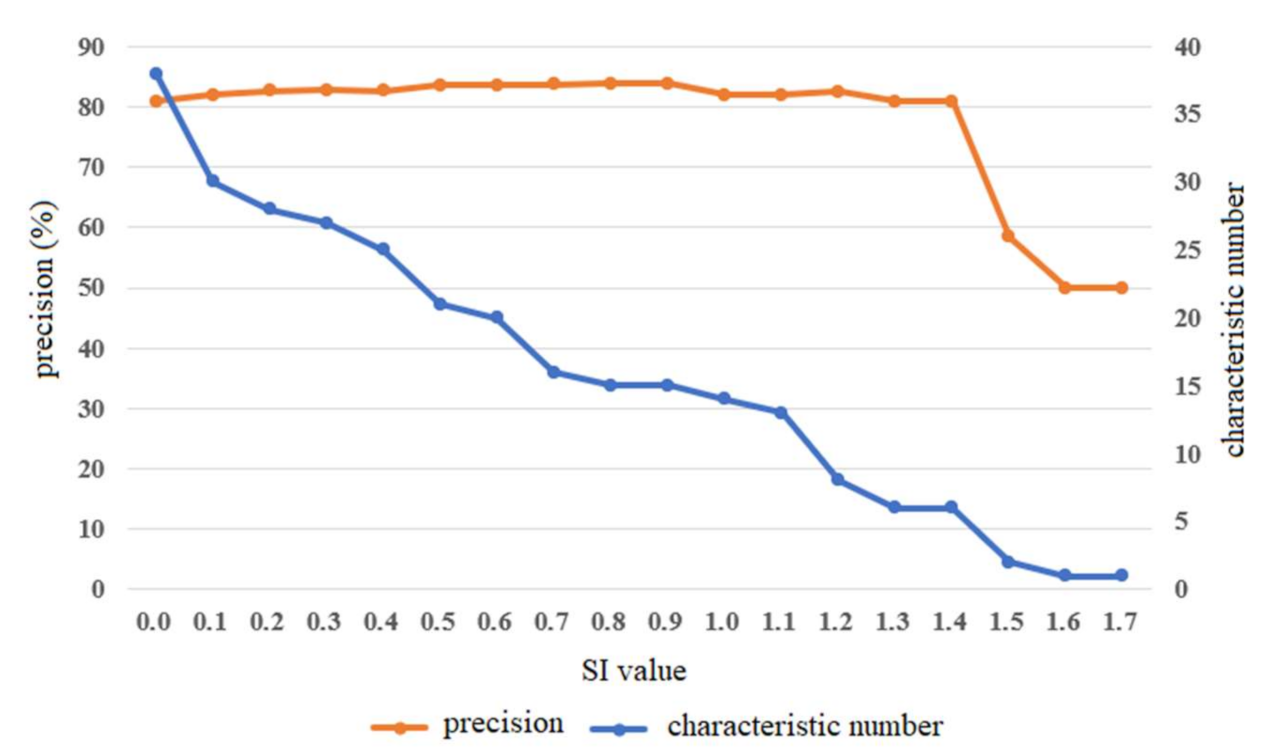
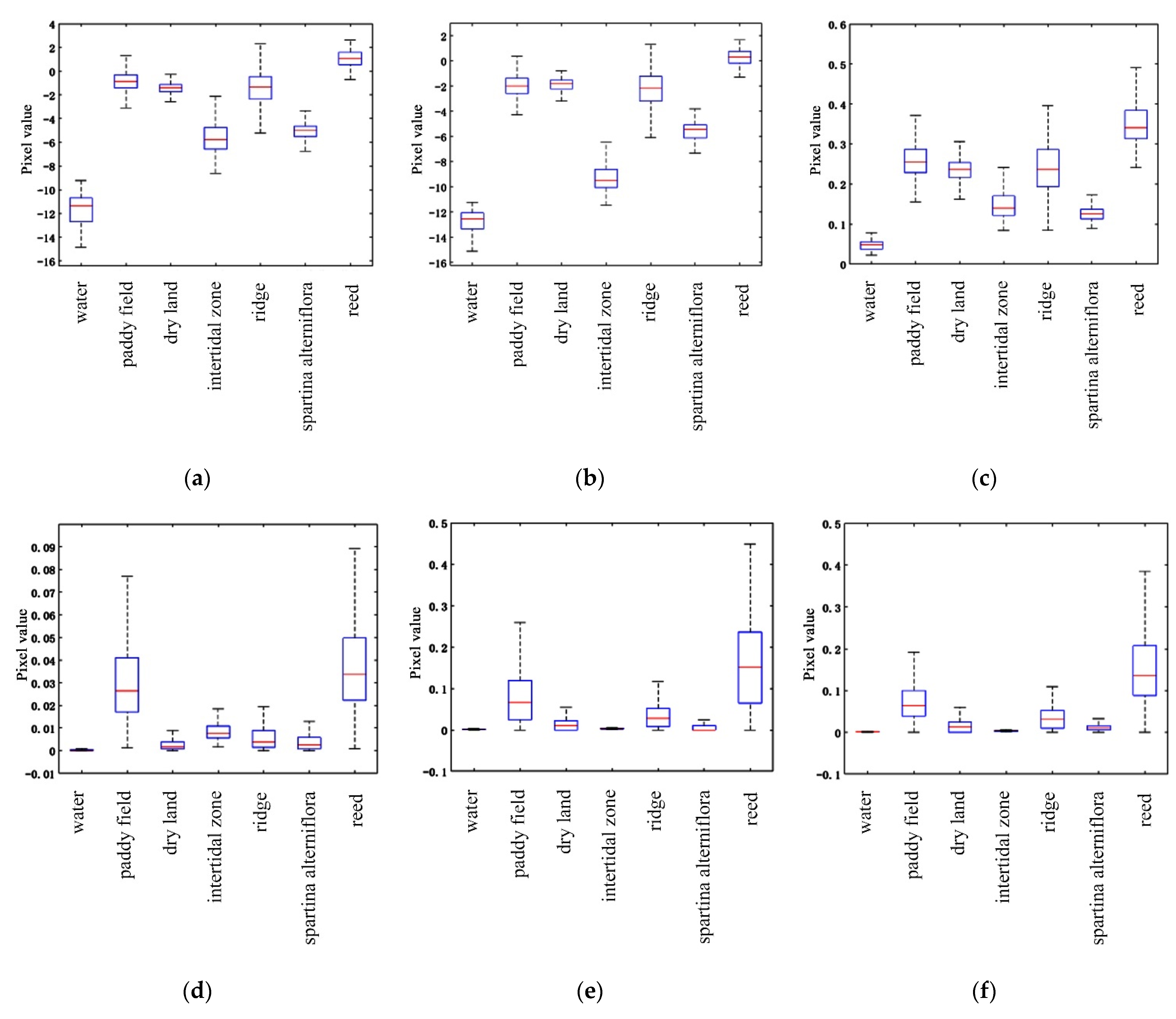
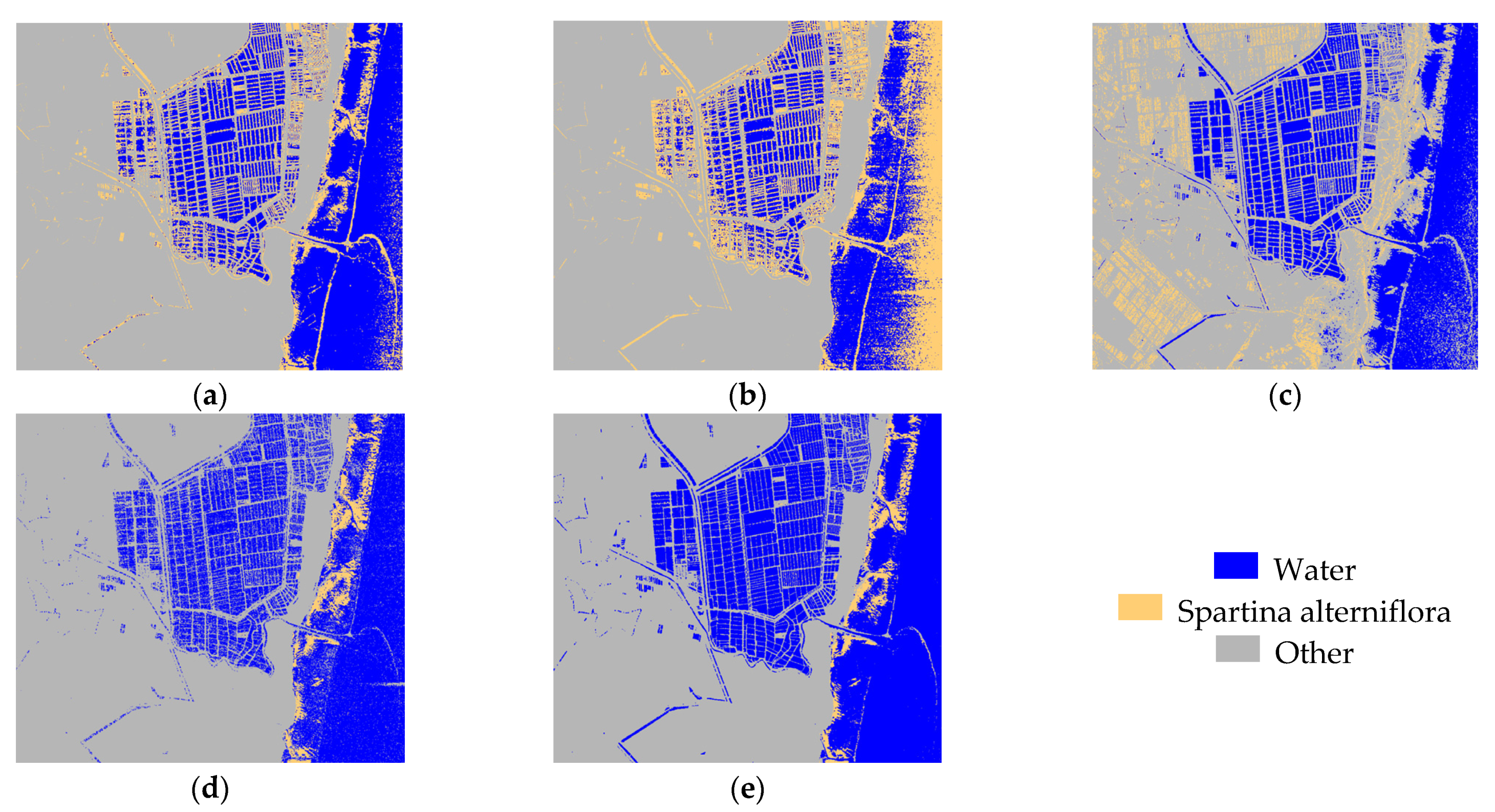
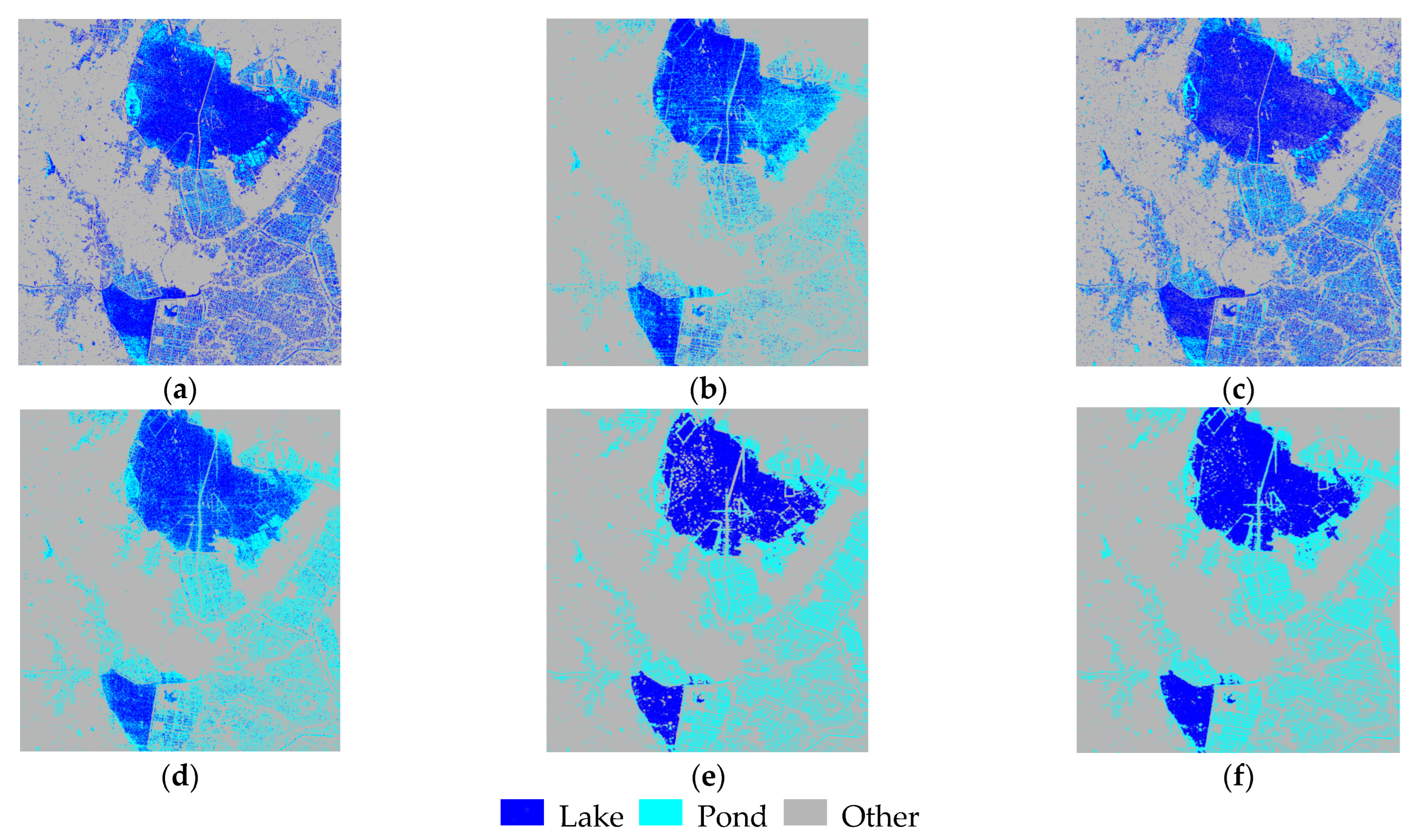
| Area | Imaging Mode | Polarization Mode | Time | Problems to Be Solved |
|---|---|---|---|---|
| Yancheng Coastal wetland | QPSI | HH/HV/VH/VV | 20 September 2017 | Mudflats are mixed with water bodies |
| Shijiu Lake | QPSI | HH/HV/VH/VV | 12 October 2018 | Distinguish between ponds and lakes |
| Pauli Matrix | Pauli Coefficient | Scattering Type | Physical Interpretation |
|---|---|---|---|
| a | Single scattering | A sphere, a plane, or a three-sided Angle | |
| b | Even order scattering | Dihedral angle | |
| c | 45° even order scattering | Dihedral Angle at 45° tilt | |
| d | Cross polarization | No corresponding scattering mechanism |
| Decomposition Method | Polarization Parameter | ||
|---|---|---|---|
| Neumann | Neu_mod | Neu_pha | Neu_tau |
| Huynen | JRH_T11 | JRH_T22 | JRH_T33 |
| Van Zyl | Van Zyl_Vol | Van Zyl_Odd | Van Zyl_Dbl |
| Krogager | Krogager_Ks | Krogager_Kh | Krogager_Kd |
| Freeman3 | Freeman_Vol | Freeman_Odd | Freeman_Dbl |
| Yamaguchi4 | Yamaguchi4_Vol | Yamaguchi4_Odd | Yamaguchi4_Hlx |
| Yamaguchi4_Dbl | |||
| H/A/Alpha | Entropy | Anisotropy | Alpha |
| L1 | L2 | L3 | |
| P1 | P2 | P3 | |
| SERD | DERD | ||
| Luneburg | Pedestal Height | ||
| Polarization Fraction | Polarization Asymmetry | ||
| Shannon Entropy | Shannon Entropy P | ||
| Shannon Entropy I | Radar Vegetation Index | ||
| Feature Set | HH | HV | VV | ALL | SI |
|---|---|---|---|---|---|
| Feature dimension | 1 | 1 | 1 | 38 | 15 |
| overall accuracy | 88.50% | 58.60% | 79.41% | 87.05% | 94.74% |
| Feature Set | HH | HV | VV | SI | SI + GLCM | SI + SI_GLCM |
|---|---|---|---|---|---|---|
| Feature dimension | 1 | 1 | 1 | 15 | 23 | 20 |
| overall accuracy | 73.73% | 55.33% | 64.30% | 83.89% | 94.34% | 94.56% |
Publisher’s Note: MDPI stays neutral with regard to jurisdictional claims in published maps and institutional affiliations. |
© 2021 by the authors. Licensee MDPI, Basel, Switzerland. This article is an open access article distributed under the terms and conditions of the Creative Commons Attribution (CC BY) license (https://creativecommons.org/licenses/by/4.0/).
Share and Cite
Wan, J.; Wang, J.; Zhu, M. Water Extraction from Fully Polarized SAR Based on Combined Polarization and Texture Features. Water 2021, 13, 3332. https://doi.org/10.3390/w13233332
Wan J, Wang J, Zhu M. Water Extraction from Fully Polarized SAR Based on Combined Polarization and Texture Features. Water. 2021; 13(23):3332. https://doi.org/10.3390/w13233332
Chicago/Turabian StyleWan, Jikang, Jiayi Wang, and Min Zhu. 2021. "Water Extraction from Fully Polarized SAR Based on Combined Polarization and Texture Features" Water 13, no. 23: 3332. https://doi.org/10.3390/w13233332






